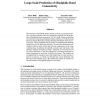100 search results - page 14 / 20 » Predicting protein folds with structural repeats using a cha... |
BMCBI
2007
13 years 7 months ago
2007
Background: The problem of protein structure prediction consists of predicting the functional or native structure of a protein given its linear sequence of amino acids. This probl...
NIPS
2004
13 years 9 months ago
2004
The formation of disulphide bridges among cysteines is an important feature of protein structures. Here we develop new methods for the prediction of disulphide bond connectivity. ...
BMCBI
2004
13 years 7 months ago
2004
Background: We establish that the occurrence of protein folds among genomes can be accurately described with a Weibull function. Systems which exhibit Weibull character can be int...
IPPS
2008
IEEE
14 years 2 months ago
2008
IEEE
Graph structure can model the relationships among a set of objects. Mining quasi-clique patterns from large dense graph data makes sense with respect to both statistic and applica...
ICPR
2008
IEEE
14 years 2 months ago
2008
IEEE
One of the major limitations of HMM-based models is the inability to cope with topology: When applied to a visible observation (VO) sequence, HMM-based techniques have difficulty ...

